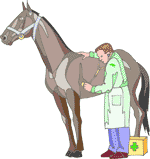Rating Your Horse's Fitness
Rating Your Horse's Fitness
This is a very important part of training for Competitive Trail Riding. There are a few tools you will need to have: 1 a stethoscope and 2 a watch with a second hand. These are needed to monitor your horse's pulse and respiration.
Each horse has a different resting pulse so start by learning what your horse's pulse is when he is resting. Place the stethoscope on the left side just behind where the girth would be, once you have found the heartbeat, time it for 30 seconds then multiply the amount you have times 2. This will give you beats per minute. Do this at different times in the day and remember that different weather will affect your horse's pulse and respiration. If it is hot out, your horse's pulse may be faster than it was on a cool day. This will help you get a good average. Once you have that you can start to rate your horse.
During a training ride at a steady pace, stop about five miles out and take your horse's pulse. Then wait five minutes and take it again, wait five more minutes for a total of 10 minutes and take it again. From this you can see, if your horse's pulse has remained at the original rate, or if it has gone down. A fit horse's pulse would go down to normal within 10 minutes. If your horse's pulse does not go down within 10 minutes, take it repeatedly to see when it does go down. This is also a sign that you need to take your training a little easier. To accurately rate your horse, you need to do this at different distances 5, 10, 20 miles etc., to be able to evaluate your horse for fatigue. This will also help you determine if your training a little to hard or if you should pick up the pace.
You should also learn how to take your horse's pulse if a stethoscope is not available. There are a few places you can do this. One is on the front legs to the inside just slightly above the knee. The other is under the jaw. You can decide which is easiest for you. These are just some basic guidelines to get you started.
I recommend discussing any training with your Veterinarian, asking questions to experience distance riders and reading books on the subject. All these items will add to your horse's safety on the ride.

- Log in to post comments
